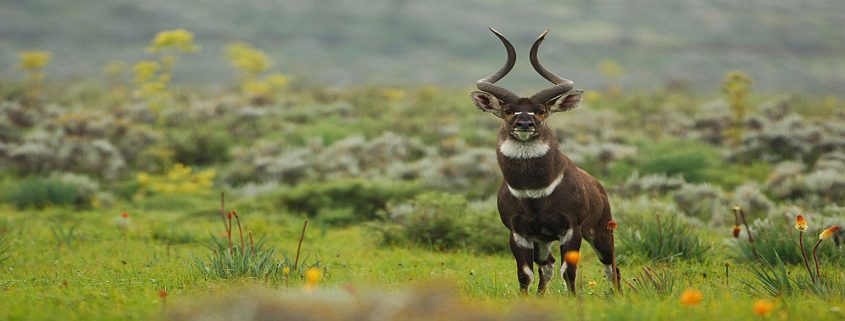Bale Mountain National Park
Lying south-east of Ethiopia, Bale Mountains National Park covers
2400 square kilometers (1488 square miles) covering wide range of
habitats and ranging in altitude from 1500 to 4377 meters (4920 to 14357
feet) at Tulu Dimtu, the highest point in the southern Ethiopia. The
spectacular Harenna escarpment running from east to west divides the
area into two major parts. To the north is a high altitude plateau area
known as the Sanetti Plateau (4000m) formed of ancient volcanic rocks
and dissected by many rivers and streams that have cut deep gorges into
the edges. In some places this has resulted in scenic waterfalls and
alpine lakes.
The vegetation here varies according to altitude.
The park can be divided into three main zones. Around Dinsho, in the
north, there are grass riverine plains, bordered by bands of bushes,
particularly sagebrush and St. John’s Wort. Wild flowers, such as Giant
Lobelia, Geraniums, ‘red-hot pokers’ and Alcheilla, form carpets of
color. Higher up the mountains heather appears either as small bushes or
as mature trees.
The second zone, the Sanetti Plateau, is home to
typical Afro-Alpine plants, some coping with the extreme temperatures by
either remaining very small or becoming large. The best example of the
latter is the curious looking Giant Lobelia, whose stems stand high
against the skyline. Wild flowers are many and various, the dominant
plant being the Helichrysum, or ’everlasting’ flowers that can be seen
in many forms. Keep an eye on the indigenous Abyssinia rose, with its
lovely subtle scent.
The Bale Mountains National Park in central Ethiopia remains
relatively undiscovered by even the most adventurous travellers, who
tend to explore the Simien Mountains in the north and the Rift Valley
Lakes in the south. This is in part due to poor access and limited
accommodation. Now, a new road has cut the journey time from the Rift
Valley Road from 10 hours to one, and at the end of it the first
high-end lodge has open.
The stream also brings rich wildlife watching: 240 species of bird,
mountain nyala (antelope), warthogs and Bale monkeys are in abundance.
There’s a research centre with a naturalist and ornithologist who spends
the day studying the park’s endemic species, and gives talks to guests
in the evenings. Not far away is the Sanetti Plateau, where endangered
Ethiopian wolves – 300 of the 500 left in the wild – can sometimes be
spotted hunting rodents in the snow.




Leave a Reply
Want to join the discussion?Feel free to contribute!